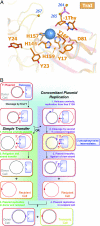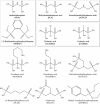Disrupting antibiotic resistance propagation by inhibiting the conjugative DNA relaxase
- PMID: 17630285
- PMCID: PMC1916486
- DOI: 10.1073/pnas.0702760104
Disrupting antibiotic resistance propagation by inhibiting the conjugative DNA relaxase
Abstract
Conjugative transfer of plasmid DNA via close cell-cell junctions is the main route by which antibiotic resistance genes spread between bacterial strains. Relaxases are essential for conjugative transfer and act by cleaving DNA strands and forming covalent phosphotyrosine linkages. Based on data indicating that multityrosine relaxase enzymes can accommodate two phosphotyrosine intermediates within their divalent metal-containing active sites, we hypothesized that bisphosphonates would inhibit relaxase activity and conjugative DNA transfer. We identified bisphosphonates that are nanomolar inhibitors of the F plasmid conjugative relaxase in vitro. Furthermore, we used cell-based assays to demonstrate that these compounds are highly effective at preventing DNA transfer and at selectively killing cells harboring conjugative plasmids. Two potent inhibitors, clodronate and etidronate, are already clinically approved to treat bone loss. Thus, the inhibition of conjugative relaxases is a potentially novel antimicrobial approach, one that selectively targets bacteria capable of transferring antibiotic resistance and generating multidrug resistant strains.
Conflict of interest statement
The authors declare no conflict of interest.
Figures




Similar articles
-
The mechanism and control of DNA transfer by the conjugative relaxase of resistance plasmid pCU1.Nucleic Acids Res. 2010 Sep;38(17):5929-43. doi: 10.1093/nar/gkq303. Epub 2010 May 6. Nucleic Acids Res. 2010. PMID: 20448025 Free PMC article.
-
Conjugative transfer can be inhibited by blocking relaxase activity within recipient cells with intrabodies.Mol Microbiol. 2007 Jan;63(2):404-16. doi: 10.1111/j.1365-2958.2006.05523.x. Epub 2006 Dec 5. Mol Microbiol. 2007. PMID: 17163977
-
Tyrosine partners coordinate DNA nicking by the Salmonella typhimurium plasmid pCU1 relaxase enzyme.FEBS Lett. 2011 Apr 20;585(8):1216-22. doi: 10.1016/j.febslet.2011.03.043. Epub 2011 Mar 23. FEBS Lett. 2011. PMID: 21439279 Free PMC article.
-
Nicking by transesterification: the reaction catalysed by a relaxase.Mol Microbiol. 1997 Sep;25(6):1011-22. doi: 10.1046/j.1365-2958.1997.5241885.x. Mol Microbiol. 1997. PMID: 9350859 Review.
-
Elements in the co-evolution of relaxases and their origins of transfer.Plasmid. 2005 Mar;53(2):113-8. doi: 10.1016/j.plasmid.2004.12.007. Plasmid. 2005. PMID: 15737398 Review.
Cited by
-
Delayed development of linezolid resistance in Staphylococcus aureus following exposure to low levels of antimicrobial agents.Antimicrob Agents Chemother. 2008 Jun;52(6):1940-4. doi: 10.1128/AAC.01302-07. Epub 2008 Mar 31. Antimicrob Agents Chemother. 2008. PMID: 18378719 Free PMC article.
-
Interaction between conjugative and retrotransposable elements in horizontal gene transfer.PLoS Genet. 2014 Dec 4;10(12):e1004853. doi: 10.1371/journal.pgen.1004853. eCollection 2014 Dec. PLoS Genet. 2014. PMID: 25474706 Free PMC article.
-
Processing of Nonconjugative Resistance Plasmids by Conjugation Nicking Enzyme of Staphylococci.J Bacteriol. 2016 Jan 4;198(6):888-97. doi: 10.1128/JB.00832-15. J Bacteriol. 2016. PMID: 26728193 Free PMC article.
-
The human gut resistome: Current concepts & future prospects.Indian J Med Res. 2019 Oct;150(4):345-358. doi: 10.4103/ijmr.IJMR_1979_17. Indian J Med Res. 2019. PMID: 31823916 Free PMC article. Review.
-
Ecology and evolution as targets: the need for novel eco-evo drugs and strategies to fight antibiotic resistance.Antimicrob Agents Chemother. 2011 Aug;55(8):3649-60. doi: 10.1128/AAC.00013-11. Epub 2011 May 16. Antimicrob Agents Chemother. 2011. PMID: 21576439 Free PMC article. Review.
References
Publication types
MeSH terms
Substances
Associated data
- Actions
- Actions
Grants and funding
LinkOut - more resources
Full Text Sources
Other Literature Sources
Chemical Information
Medical

